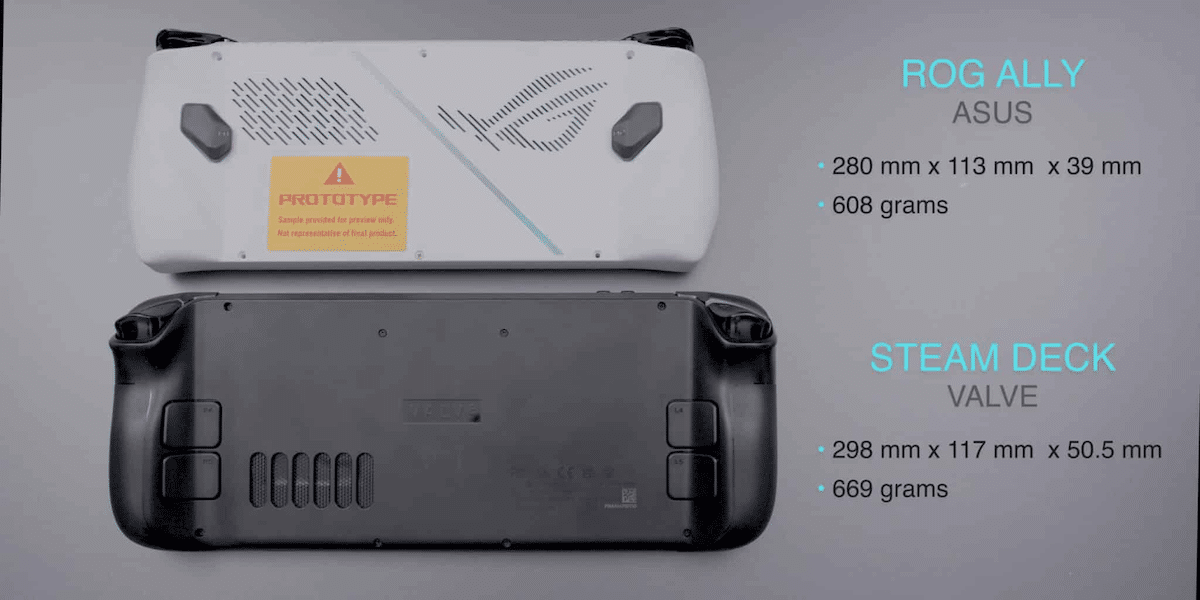With the surprise announcement of the ROG Ally, ASUS, the Taiwanese manufacturer, managed to capture the attention of the large gaming community. She is dubbed by many as the first real Steam Deck competitor from a major company. Naturally, excitement is high, despite no major information being released so far.
But through our research, we believe we can create a more complete picture of what the ROG Ally might look like. Let’s go.
? What is ROG Ally?
L’Asus ROG Ally est a portable game console which runs on Windows 11. Its goal is to compete with the Steam Deck console. It has an AMD Zen 4 RDNA 3 APU processor engraved in 4 nm and a 7-inch Full HD screen in 16: 9 format. The display offers 500 nits of brightness and 120Hz refresh rate, which ensures an immersive gaming experience.
The idea, according to ASUS, is to create a console capable of playing all PC games with higher fidelity than the Steam Deck in a Windows environment.

The console is more compact than the Steam Deck and has less prominent handles, which can make it less comfortable to grip. However, it has a USB-C port and an XG Mobile expansion port on the top. Although it does not have a touchpad, this may not be a disadvantage for certain games that do not require the use of a mouse.
? ASUS ROG Ally: what release date?
ASUS ROG officially announced that the release of the ROG Ally was imminent on their Twitter page, but without specifying an exact date or timeframe. Customers in North America can already sign up for notifications on Best Buy, which is why the product might be available sooner than expected, as mentioned in the announcement tweet.
So far, the best information we have comes from u/remy2fly on Reddit, who claims to have had the handheld device in hand. In a post on the r/GamingLeaksAndRumours subreddit, they claim that ASUS ROG Ally release date set for October 2023but we can’t be sure that what they say has any relevance, because someone with access to this kind of confidential information would not reveal their sources.
So, for now, this release date is just a rumor, but it’s the only rumor we have so far, so we’ll take it with a healthy dose of caution.
? ASUS ROG Ally: what price?
The price of the ASUS ROG Ally remains unknown to this day. However, to compete with the Steam Deck, the console will need to be offered in a similar price bracket. While Valve can afford to sell every console at a loss and then recoup that money through selling games on Steam, where they take a 30% commission on each item sold, ASUS can’t afford the same strategy.
Given the rumors about its performance, it’s easy to imagine the Asus ROG Ally selling in a price range below 1000 euros. This is the case of OneXPlayer, the closest competitor, which offers its products at similar prices. However, this may not be enough to convince consumers: because if one can immediately answer that the Steam Deck is cheaper, this will not be a very attractive argument for ASUS.
Despite everything, it is difficult to say how much the console will be offered by ASUS. The ROG Ally could be offered at a price between 400 and 700 euros, which we believe would be ideal. For comparison, the Steam Deck is available with 64 GB of storage at 419 euros, 256 GB of storage at 549 euros and 512 GB of storage at 679 euros.
⚒️ ASUS ROG Ally: which technical sheet?
Although Asus has yet to release details on the release date and price of their first handheld game console, numerous leaks have provided some indications. One of the main features of the Asus ROG Ally is a custom AMD Ryzen Z1 Extreme chipwhich appears to be a modified version of the Ryzen 7 7840U.
From LTT and Dave2D, we know that the screen of the ASUS ROG Ally will be a 7-inch IPS panel in 1080p with a maximum brightness of 500 nits and a refresh rate of 120 Hz in a 16:9 aspect ratio. That’s twice the refresh rate of the Steam Deck, which is 60Hz on a 400-nit 800p 16:10 panel.

ASUS’ latest handheld console will also feature a host of ports and system controls. She should enjoy a 3.5 mm combo mini-jack headphone socketa UHS-II microSD slot, and a USB-C port that also connects to the ASUS ROG XG Mobile external GPU.
Besides the console itself, you’ll also get a 65-watt adapter that will charge the Ally via USB-C, which will have an additional USB-A port and will also act as an HDMI output. So the adapter that comes in the box could also work as a sort of docking station.
It is not yet known if the ROG Ally will use a native landscape mode display or not. Most devices — including the Steam Deck and even the original Nintendo Switch — use portrait mode displays set to landscape mode in their firmware. This is because most displays these days are created for use in smartphones and tablets, and manufacturers often choose existing parts to save on cost.
Here is the possible technical sheet of the ROG Ally:
- CPU : AMD Ryzen Z1 Series (specs unconfirmed)
- DISPLAY : Écran Full HD 1080p 120 Hz (500 nits 7ms)
- RAM : 16 Go LPDDR5 Canal double
- STORAGE : M.2-2230 512 Go PCIe Gen4
- OPERATING SYSTEM : Windows 11
- WEIGHT : 608 g
- PORTS : 1 prise mini-jack 3,5 mm, 1 emplacement microSD, 1 port USB-C
- PRIX : between 400 and 700 € (speculation)
? ASUS ROG Ally: what performance?
A recent Geekbench listing confirmed this information and also provided insight into the ROG Ally’s performance. She gets an impressive score of 35,498 in the OpenCL benchmark from Geekbench, with performance similar to other Radeon 780M GPUs. According to an earlier leak, the handheld console is expected to compete with a GTX 1650 Max-Q, putting it ahead of rivals such as the Steam Deck.
Additionally, the listing reveals that the ASUS ROG Ally’s CPU boost frequency is set to 5.0 GHz for a 15 watt chip. That’s impressive, but to run its FHD display at 120 FPS, the handheld console will need maximum computing power. It will be interesting to see how AMD and Asus have optimized the console.

Since the Ally will be powered by Windows 11, you won’t be limited to specific game and app stores like the Steam Deck. You’ll be able to run titles from other publishers and stores, such as EA Play, Epic Games, Xbox and, of course, Steam.
Of course, given that ROG Ally runs on Windows, it’s entirely possible that its capabilities extend beyond just gaming, giving users portable access to other Microsoft features. However, this is only speculation.
The console should be much quieter than the Steam Deck, which in all honesty can get quite loud with the most demanding titles. In tests conducted by Dave2D, the ASUS ROG Ally’s fan noise topped out at 20dB, while the Steam Deck came in at 37dB. It may not seem like much on paper, but in reality it’s a huge disparity.
? ASUS ROG Ally vs Steam Deck: what’s the difference?
The ASUS ROG Ally will be the main competitor of Valve’s Steam Deck, as both devices have similar functionality. But there are two key differences that set them apart.
As for specs, ROG Ally uses a custom APU leveraging AMD Zen 4 processor architecture and RDNA 3 graphics architecture. old Zen 2 architecture and a GPU using RDNA 2. In general, the technical sheet of the ROG Ally is overall more muscular.
The Asus console will also be smaller: 280 x 113 x 39 mm, compared to 298 x 117 x 50.5 mm for the Steam Deck. It will weigh 608 grams against 669 for the Valve console.

But one of the most important aspects that sets the two devices apart is the operating system. The Steam Deck uses SteamOS, while the ROG Ally uses Windows 11. Although SteamOS offers an easy-to-use interface for portable gaming, it’s still in its infancy and doesn’t support playing some games, including games on marketplaces other than Steam.
On the other hand, Windows 11 allows playing games in other stores. However, Windows 11 is a full-featured operating system, with a lot of overhead that could potentially reduce the Ally’s battery life.
? ASUS ROG Ally: what autonomy?
Not much is known about battery life. Asus, in its statement to LTT and Dave2D, said it would be ” very competitive “. That’s not saying much, but we suspect it could be about the same within 15 watts of the Steam Deck, which ranges in battery life between 90 minutes and 3 hoursdepending on the game.
We will continue to update this file as we gather information.
